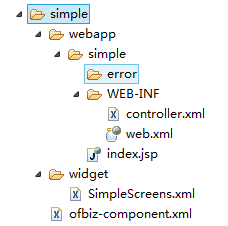OFbiz--HelloWorld
上篇博客《OFbiz--简介》我们介绍了OFbiz是什么,下面我们就开始用OFbiz开发我们的第一个程序--HelloWorld。步骤如下:
首先在hot-deploy下新建文件夹simple。目录结构如下:
1.ofbiz-component.xml文件配置
此文件为程序的启动配置,配置webapp的名称、位置、权限、信息。
<?xml version="1.0" encoding="UTF-8"?>
<ofbiz-component name="simple" xmlns:xsi="http://www.w3.org/2001/XMLSchema-instance"
xsi:noNamespaceSchemaLocation="http://ofbiz.apache.org/dtds/ofbiz-component.xsd">
<resource-loader name="main" type="component"/>
<webapp name="simple"
title="Simple"
server="default-server"
base-permission="OFBTOOLS"
location="webapp/simple"
mount-point="/simple"
app-bar-display="false"/>
</ofbiz-component>
2.web.xml文件配置
配置默认的实体加载器、分发器、装饰器。可以与springMVC或struts的项目中的web.xml进行比较,会发现有些地方是相同的。做为MVC模式的项目,在配置文件中都需要配置ControlServlet进行请求分法。
<?xml version="1.0" encoding="UTF-8"?> <!DOCTYPE web-app PUBLIC "-//Sun Microsystems, Inc.//DTD Web Application 2.3//EN" "http://java.sun.com/dtd/web-app_2_3.dtd"> <web-app> <!-- 有关实体引擎 --> <context-param> <param-name>entityDelegatorName</param-name> <param-value>default</param-value> </context-param> <!-- 有关服务引擎 --> <context-param> <param-name>localDispatcherName</param-name> <param-value>school</param-value> </context-param> <!-- 有关界面装饰器 --> <context-param> <param-name>mainDecoratorLocation</param-name> <param-value>component://simple/widget/SimpleScreens.xml</param-value> </context-param> <!-- 配置访问过滤器 --> <filter> <filter-name>ContextFilter</filter-name> <display-name>ContextFilter</display-name> <filter-class>org.ofbiz.webapp.control.ContextFilter</filter-class> <init-param> <param-name>disableContextSecurity</param-name> <param-value>N</param-value> </init-param> <init-param> <param-name>allowedPaths</param-name> <param-value>/error:/control:/select:/index.html:/index.jsp:/default.html:/default.jsp:/images:includes/maincss.css</param-value> </init-param> <init-param> <param-name>errorCode</param-name> <param-value>403</param-value> </init-param> <init-param> <param-name>redirectPath</param-name> <param-value>/control/main</param-value> </init-param> </filter> <filter-mapping> <filter-name>ContextFilter</filter-name> <url-pattern>/*</url-pattern> </filter-mapping> <!-- 配置控制监听器 --> <listener> <listener-class>org.ofbiz.webapp.control.ControlEventListener</listener-class> </listener> <!-- 配置登录监听器 --> <listener> <listener-class>org.ofbiz.webapp.control.LoginEventListener</listener-class> </listener> <!-- 配置核心控制器 --> <servlet> <servlet-name>ControlServlet</servlet-name> <servlet-class>org.ofbiz.webapp.control.ControlServlet</servlet-class> <load-on-startup>1</load-on-startup> </servlet> <servlet-mapping> <servlet-name>ControlServlet</servlet-name> <url-pattern>/control/*</url-pattern> </servlet-mapping> <!-- 配置session过期时间 --> <session-config> <session-timeout>60</session-timeout> </session-config> <!-- 配置默认界面 --> <welcome-file-list> <welcome-file>index.jsp</welcome-file> <welcome-file>index.html</welcome-file> <welcome-file>index.htm</welcome-file> </welcome-file-list> </web-app>
3.controller.xml
配置request请求及请求的视图。
<?xml version="1.0" encoding="UTF-8"?>
<site-conf xmlns:xsi="http://www.w3.org/2001/XMLSchema-instance"
xsi:noNamespaceSchemaLocation="http://ofbiz.apache.org/dtds/site-conf.xsd">
<include location="component://common/webcommon/WEB-INF/common-controller.xml"/>
<!-- Request Mappings -->
<request-map uri="main">
<security https="false" auth="false"/>
<response name="success" type="view" value="main"/>
</request-map>
<!-- View Mappings -->
<view-map name="main" type="screen" page="component://simple/widget/SimpleScreens.xml#main"/>
</site-conf>
4.SimpleScreens.xml
配置界面信息,一个screen是一个定义的界面。
<?xml version="1.0" encoding="UTF-8"?>
<screens xmlns:xsi="http://www.w3.org/2001/XMLSchema-instance"
xsi:noNamespaceSchemaLocation="http://ofbiz.apache.org/dtds/widget-screen.xsd">
<screen name="main">
<section>
<widgets>
<label text="Hello World"/>
</widgets>
</section>
</screen>
</screens>
5.访问
访问地址:http://localhost:8080/simple/control/main
结果如下:
总结
通过如上操作,我们建立了自己的第一个OFbiz程序,这个程序不涉及实体的CRUD、不涉及请求的重定向、不涉及表单拼装界面、不涉及请求服务。下面我们会一点点的完善这个Demo.
大家可以感受到使用OFbiz如此简单,没有一行java代码,全是xml配置文件。大家只要熟悉xml的编写规范即可快速上手。

